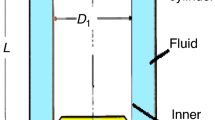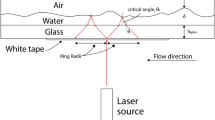Conclusions
-
1.
A film transducer can be used to estimate accurately the shear resistance of a material behind a shock-wave front.
-
2.
The shear resistance up to 30 kbar differs little from that for the elastic precursor.
Similar content being viewed by others
Literature Cited
G. V. Stepanov, “A method of recording elastoplastic stress waves in solids,” Probl. Prochnosti, No. 10 (1972).
G. V. Stepanov, “Dielectric transducers for measuring shock waves: analysis of methods,” Probl. Prochnosti, No. 4 (1974).
V. V. Astanin and G. V. Stepanov, “An explosive forge for testing constructional materials in planar shock waves,” Probl. Prochnosti, No. 12 (1973).
G. V. Stepanov, “Propagation of planar waves in a viscoplastic material showing linear hardening,” Probl. Prochnosti, No. 10 (1975).
G. V, Stepanov and V. V. Astanin, “Shock compression of some constructional materials at speeds up to 1000 m/sec,” Probl. Prochnosti, No. 9 (1975).
P. M. Ogibalov and I. A. Kiko, Outlines of Extreme-Condition Mechanics [in Russian], MGU, Moscow (1966).
Additional information
Kiev. Translated from Problemy Prochnosti, No. 4, pp. 94–98, April, 1976.
Rights and permissions
About this article
Cite this article
Stepanov, G.V., Astanin, V.V. Determination of shear resistance behind a shock-wave front. Strength Mater 8, 477–482 (1976). https://doi.org/10.1007/BF01528112
Received:
Issue Date:
DOI: https://doi.org/10.1007/BF01528112




